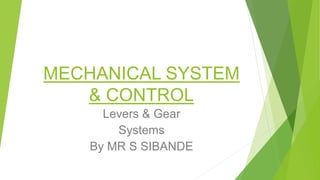Technology presentation ( fsm)
- 1. MECHANICAL SYSTEM & CONTROL Levers & Gear Systems By MR S SIBANDE
- 2. LESSON OBJECTIVES LEARNERS SHOULD BE ABLE: ’ü▒ To define lever and gears ’ü▒ To identify the three types of levers. ’ü▒ To label the parts of lever system. ’ü▒ Determine the mechanical advantage of various lever systems. ’ü▒ To identify all types of gears & ratio.
- 3. LEVERS ’üĄ Lever - is a rigid bar resting on a pivot, used to move a heavy or firmly fixed load with one end when pressure is applied to the other. ’üĄ The three lever system parts: Fulcrum, effort & load(resistance) Fulcrum(pivot) -the central point, pin, or shaft on which a mechanism turns. Effort -The force applied to a machine to cause motion of an object. (Newton) Load(resistance) -The force exerted by an object due to gravity or friction.(Newton) Mechanical Advantage ŌĆō The number of times a machine multiplies the effort force. MA= Ed/Ld ’āś three classes of levers: 1st, 2nd and 3rd class.
- 5. EXAMPLES OF CLASS LEVERS
- 6. PARTS OF LEVER SYSTEM A= LEVER B=FULCRUM C=LOAD DISTANCE D=LOAD FORCE E=EFFORT ARM F=EFFORT FORCE G=EFFORT DISTANCE H=LOAD ARM
- 7. MECHANICAL ADVANTAGE OF LEVERS MA= Ed/Ld(Rd) Lf = Ef x MA Ef = Lf / MA LOAD= RESISTANCE (L= R)
- 8. TYPES OF GEARS ’üĄ A gear is a component within a transmission device that transmits rotational force to another gear or device. A gear is a wheel with teeth that mesh together with other gears. 1. SPUR GEAR.- Teeth is parallel to axis of rotation, it transmit power from one shaft to another parallel shaft and it uses in Electric screwdriver, oscillating sprinkler, windup alarm clock, washing machine and clothes dryer
- 9. GEARS CONTŌĆÖ ’üĄ BEVEL GEAR-Are useful when the direction of a shaft's rotation needs to be changed and are usually mounted on shafts that are 90 degrees apart, but can be designed to work at other angles as well. The teeth on bevel gears can be straight, spiral or hypoid locomotives, marine applications, automobiles, printing presses, cooling towers, power plants, steel plants, railway track inspection machines, etc. ’üĄ WORM GEAR-are used when large gear reductions are needed. Also in widely in material handling and transportation machinery, machine tools, automobiles etc.
- 10. GEARS CONT & RATIOS ’üĄ IDLER GEAR BELT AND PULLY Gear ratio is the ratio of the number of teeth on one gear to the number of teeth on the other gear. Velocity ratio (V.R.=Ed/Ld)









